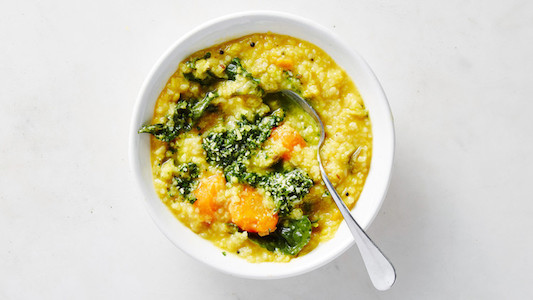Transitioning into Autumn
Ayurveda and a Recipe from our Osteopath Bron
 Autumn in upon us (already!) and, consequently, the corresponding weather patterns which accompany it. Transition seasons such as autumn and spring – we call them transitions due to the fact that they are mediums between the extremes of summer and winter – are times when our bodies tend to struggle.
Autumn in upon us (already!) and, consequently, the corresponding weather patterns which accompany it. Transition seasons such as autumn and spring – we call them transitions due to the fact that they are mediums between the extremes of summer and winter – are times when our bodies tend to struggle.
It can be challenging to regulate internal processes as the seasons move, and this may manifest in a multitude of ways: commonly, we may find our immune systems struggling to keep up with the daily grind with so many colds and flus flying about!
Why is it that this happens?
Often it can be due to our nutritional intake. Our rational brain takes a bit longer to compute the changes happening in our external environment. As the weather changes, so too do our nutritional needs.
We move from eating summer type foods – more raw vegetables, salads and the like – to cooked, warmer foods as we move into winter. Accompanying this is also our fluid intake and heating / cooling system. Again, moving from drinking cold beverages to warmer nourishing refreshments. There is a lag, which tends to happen in the change of habits on the nutritional front and our body’s internal needs. Our body will require the changes before most of us realize, and make the appropriate nutritional changes.
I personally use the coconut oil in my cupboard as my (rough) barometer: if it is liquid at room temperature, then it is ok to eat more cool, raw foods. If it is solid, cloudy or semi-solid then it is time to cook up some hearty, warm foods!
In Ayurveda and Chinese medicine, the practice of nutrition and attention to the changing seasons is paramount to good health and well-being.
I cook an Ayurvedic recipe frequently throughout autumn in order to assist my body in adapting to the changes in the weather. I encourage you to try it out!
It is also important to consider your physical body (aches and pains) within the context of the changing seasons. Remember to book in to see your osteopath to have a tune up, and allow some restoration of equilibrium to your system, which will be a lovely adjunct in maintaining good health and function 🙂
Kitchari Recipe
 Ingredients:
Ingredients:
1 cup Basmati Rice
1 cup Mung Dahl (split yellow)
7 cups Water
Pinch of Salt & Pepper
1 tbs Ghee
3 tsp Dried Ginger
2 tsp Dried Cumin Powder
2 tsp Turmeric Powder
2 tsp Coriander Seed Powder
2 tsp Dried or Fresh Fenugreek
1/2 tsp Asafoetida (Hing) Powder
Diced Vegetables: e.g. Pumpkin, Sweet Potato, Carrot, Peas, Zucchini
Method:
- Rinse dahl thoroughly.
- In a large saucepan, heat ghee before adding spices. Add the vegetables, mung dahl, and rice, stirring to coat.
- Add water, stir through, and then bring to the boil.
- Reduce the heat and simmer for 15-20 minutes – until the dahl and rice are soft. Do not disturb while simmering to avoid a gluggy Kitchari!
Eat at least 3 small bowls per day.
To re-heat your Kitchari, simply add a little water before heating in a pan or microwave.
Kitchari – by Martha Stewart.